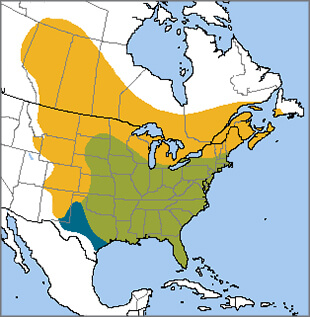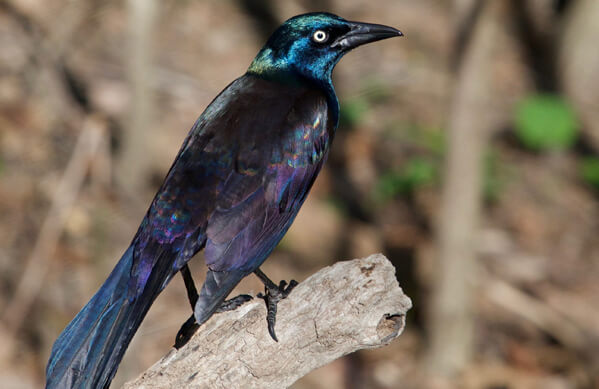 Common Grackles are recognized by their long, keel-shaped tails, fairly heavy and sharp bills, yellow eyes, and (in males) glossy black plumage with an iridescent sheen. The word "grackle" derives from the Latin word for Europe's jackdaw, a somewhat similar-looking but unrelated bird.
Common Grackles are recognized by their long, keel-shaped tails, fairly heavy and sharp bills, yellow eyes, and (in males) glossy black plumage with an iridescent sheen. The word "grackle" derives from the Latin word for Europe's jackdaw, a somewhat similar-looking but unrelated bird.
The Common Grackle belongs to the Icteridae family, so is related to the Rusty Blackbird, Tricolored Blackbird, and Baltimore Oriole. These birds have an interesting trait that helps them use the earth's geomagnetic fields to navigate.
The Grackle's Special Senses
Common Grackles, along with many other bird species ranging from the Chimney Swift to Northern Bobwhite, have a magnetic mineral called magnetite in their heads, beaks, and necks. This mineral allows birds to use the earth's geomagnetic fields to navigate.
Other animals, including bees, fish, turtles, whales, and bats, also use the geomagnetic field as a navigation aid. Research suggests that people also have a subconscious "magnetic sense," although its function remains unknown.
Bronzed vs. Purple Subspecies
The Common Grackle breeds across North America east of the Rocky Mountains, withdrawing from the northern and northwestern portion of its range in winter. It is considered a partial migrant throughout the southeastern part of its range, moving relatively short distances between breeding and wintering sites.
Three subspecies are recognized, mostly differing in plumage color. The nominate subspecies, found in New England and west to the Rocky Mountains, was once considered a separate species, the "Bronzed" Grackle. True to its former name, males have bronze body plumage that contrasts with a purplish tail and blue-green head. These grackles are the most mobile of the three subspecies, migrating in large flocks to the southeastern United States each winter.
Sign up for ABC's eNews to learn how you can help protect birds
In the states east of the Appalachians, from New York to North Carolina, males of the “Purple” Grackle subspecies have a purple sheen on the back. Males of the third subspecies, which occurs from Louisiana to South Carolina and Florida, are the least colorful, but still show the characteristic shimmering blues and greens on their dark plumage.
Common Grackles are very vocal birds, but their decidedly unmelodic song is often compared to the sound of a squeaky, rusty gate opening and closing. Have a listen:
(Audio by Ted Floyd, XC365161. Accessible at www.xeno-canto.org/365161)
Socialite Species
Common Grackles are highly social, migrating, wintering, and roosting in large flocks, often mixed with other species including the Red-winged Blackbird, Brown-headed Cowbird, and European Starling. Wintering flocks may be especially large, sometimes numbering over a million birds! The spectacle of these enormous flocks swirling over fallow fields is an impressive one, stopping even nonbirders in their tracks for a second look.
Like the Osprey and Northern Mockingbird, the Common Grackle begins to nest early in the spring, often by late March or early April. Ever social, Common Grackles often form large colonies of up to 200 nests, preferably in thick cover such as pine groves. Even individuals nesting apart from the colony still may join roosts each night.
Males and females form breeding pairs in early spring, flying together and performing displays for each other to solidify their pair bond. Males' varied displays discourage rivals and include vertical head tilts, plumage fluffing, and the "V-tail display," in which the bird lowers its central tail feathers to form a V while wildly flapping its wings.
Adult Common Grackles sometimes help unrelated pairs at the nest; in one case, two different males were seen visiting the same nest to feed the young.

Common Grackle, bronze form. Photo by Mircea Costina, Shutterstock
An Enterprising Feeder
Common Grackles, like Common Ravens, are omnivorous and will take advantage of almost any available food source, including insects, minnows, frogs, eggs, berries, seeds, grain, and garbage. In coastal areas, grackles will forage along the shoreline for small invertebrates, sometimes even wading into the water to grab live fish. Common Grackles will eat other birds' eggs and nestlings, and sometimes attack and devour the adults as well.
Always enterprising, these birds often follow plows to grab churned-up grubs, and have even been seen stealing earthworms from robins!
Use of Ants … and Marigolds
Common Grackles (among many other birds, including flickers) indulge in an interesting behavior known as "anting." A bird will lie on the ground near an ant nest, allowing the insects to crawl over and among its feathers. The ants secrete formic acid on the bird's plumage, which helps to repel lice and other parasites that commonly infest bird feathers.
Grackles have also been seen dabbing other natural insect repellents on their plumage, including marigold flowers, lemon pieces, walnut juice, and chokecherry juice.
Large Flocks, Falling Numbers
Although the Common Grackle is one of the most widespread bird species in North America, the Partners in Flight (PIF) 2016 Landbird Conservation Plan notes that its numbers have declined by more than 50 percent in the United States and Canada. PIF considers it a "Common Species in Steep Decline." The International Union for the Conservation of Nature (IUCN) recently declared it Near Threatened, citing a large-scale decline of more than 60 percent over 40 years as a reason for this revised ranking.
Even so, the Common Grackle is considered an agricultural pest species in North America, since huge wintering flocks can cause millions of dollars in damage to corn, rice, sunflower, and other crops. Lethal control measures are often used to stop the damage and may be contributing to Common Grackle declines.
Donate to support ABC's efforts to protect migratory birds!



















































